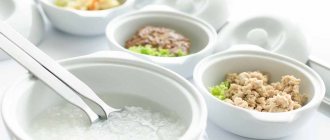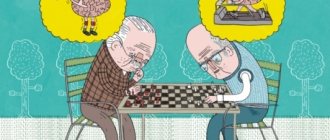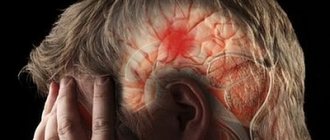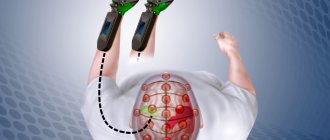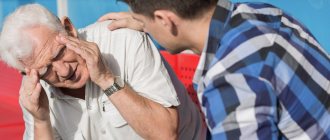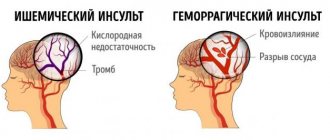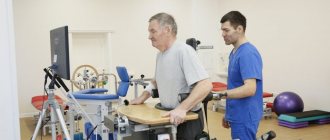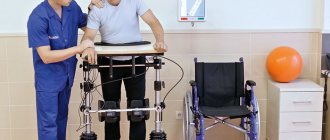Issues discussed in the material:
- What are the consequences of different types of strokes in older people?
- What are the main areas of rehabilitation of an elderly person after a stroke that need to be covered?
- How quickly will an elderly person recover from a stroke, and what affects this period?
The recovery of an elderly patient after a cerebral hemorrhage depends on many factors. But the main thing during the recovery period is complete care and proper rehabilitation after a stroke in an elderly person. Otherwise, the outcome of the disease can result in severe complications - from loss of motor functions to mental illness and even death.
Rehabilitation after a stroke in an elderly person and recovery time
We recommend
“How to communicate with elderly parents so that everyone feels comfortable” Read more
Rehabilitation after a stroke in an elderly person should be complete; it is extremely important to make every effort so that the patient returns to a full life as soon as possible. For a quick recovery, it is best to undergo rehabilitation in specialized institutions where comprehensive treatment will be prescribed. Of course, recovery will take a lot of time; each case of the disease is individual. Some will take years, while others will get back on their feet in just a few months.
There are three stages of rehabilitation after a stroke in an elderly person:
- Early rehabilitation (six months).
- Late recovery (from 6 months to a year).
- Residual rehabilitation (at least a year has passed since the stroke).
During the first three months, the strength and functions of the affected part of the body are restored. The success and effectiveness of rehabilitation after a stroke in an elderly person largely depends on timely and competent treatment. According to doctors, the most important period of recovery is the first year.
The first six months are a favorable time for the rehabilitation of speech and motor functions after an attack. Many families place relatives after a cerebral hemorrhage in specialized boarding houses. This is explained by the fact that for effective treatment and recovery of the patient, the person caring for him must have at least primary skills and basic knowledge. Otherwise, the end result may be unsatisfactory.
In the first few days, the patient must be protected from any negativity and a favorable microclimate must be created. It is very important to talk to an older person and share good news.
The recovery period takes a long time, during which the patient undergoes complex treatment:
We recommend
“Adaptation of older people: in modern society and boarding homes” More details
1. Taking medications.
2. Physical activity:
- restorative gymnastics and physical education;
- massage treatments;
- physiotherapeutic manipulations (electrophoresis, healing baths, magnetic therapy).
3. Psychological support:
- a course with a psychologist;
- restoration of everyday and social skills;
- communication with other people.
4. Following a special diet - avoiding fried, fatty, spicy foods, alcohol, coffee. It is recommended to consume more foods rich in beneficial vitamins and microelements that stimulate the functioning of the brain and the body as a whole.
5. Restoration of the speech apparatus, logical thinking and memory:
- a course of lessons with a speech therapist;
- solving problems and puzzles;
- singing and reading lessons.
6. Rehabilitation of the musculoskeletal system:
- gymnastics, training on simulators;
- visiting the swimming pool;
- walking.
Throughout the entire course of rehabilitation with an elderly person after a stroke, relatives should be nearby; their goal is to surround the patient with love and care. For an elderly patient, this is the best medicine, giving strength and vigor for a speedy recovery and restoration of lost functions.
Recommended articles on this topic:
- Features of older people: psychological and physiological
- The main problems of older people and ways to solve them
- Boarding home for the elderly: features and rules of choice
Treatment of acute ischemic stroke
In Russia, stroke ranks second in the structure of overall mortality and is the main cause of permanent disability: approximately 20% of patients who have had a stroke become severely disabled and require outside help. Among all types of stroke, ischemic brain damage predominates.
Ischemic stroke is a heterogeneous clinical syndrome. According to the international TOAST criteria, several pathogenetic variants of ischemic stroke are distinguished: stroke associated with damage to large arteries and developing as atherothrombosis or arterio-arterial embolism; cardioembolic stroke; microvascular (lacunar) stroke; rare forms (moya-moya syndrome, stroke due to inflammation of the vessel wall (vasculitis), dissection (dissection) of the arterial wall, etc.), as well as undifferentiated forms. Treatment and secondary prevention of ischemic stroke should be carried out taking into account its pathogenetic variant.
In the early 1990s. It has been shown that the development of infarction in the first minutes and hours of the disease occurs through rapid mechanisms of necrotic cell death. The trigger point is an energy deficiency, which initiates the so-called glutamate-calcium cascade, characterized by excessive release of excitatory aminacidergic neurotransmitters - aspartate and glutamate - and excessive intracellular accumulation of Ca2+ ions - the main trigger of the final mechanisms of the cascade, leading to cell death.
The formation of the nuclear zone (“core” of the infarction) is completed within 5–8 minutes from the moment of acute cerebrovascular accident. This area of the brain is surrounded by a potentially viable zone of the “ischemic penumbra” (penumbra), in which the level of blood flow is reduced, but energy metabolism is generally preserved and functional, but not structural, changes are present.
The formation of 50% of the total volume of the infarction occurs within the first 90 minutes from the moment of stroke development, 70-80% - within 360 minutes, and therefore the first 3-6 hours of the disease are called the “therapeutic window”, within which therapeutic measures can be taken most effective by saving the penumbra zone.
At the same time, the processes that began in the first hours of the disease retain their significance at a later date, especially when the area of ischemic damage is extensive. They induce and support other “long-term consequences of ischemia”: a genome reaction with the inclusion of genetically programmed molecular programs, dysfunction of the astrocytic and microglial cell pools with the development of immune changes and local inflammation at the site of ischemia, disruption of microcirculation and the blood-brain barrier. The time for “additional formation” of infarct changes in each case is individual and ranges from 3 to 7 days from the moment of cerebrovascular accident.
Therefore, in case of a stroke, it is very important to provide quick and pathogenetically based medical care, preferably within the first 2–3 hours from the moment of its development.
Modern understanding of the mechanisms of development of ischemic stroke has made it possible to identify two main directions of pathogenetic therapy: improving the perfusion of brain tissue (early recanalization of the vessel and reperfusion) and neuroprotective therapy.
When adequate perfusion of brain tissue is restored, clinical improvement in patients can be expected even if they do not have a visualized zone of diffusion-perfusion mismatch on MRI.
Carrying out therapeutic reperfusion is advisable within 3–6 hours, then its use significantly increases the risk of not only reperfusion damage, but also hemorrhagic complications. Thus, reperfusion should be early, active and short-term if possible.
The nature of reperfusion therapy is determined by the pathogenetic variant of stroke development. In case of occlusion of medium- and large-caliber arteries, the effectiveness of therapeutic measures is determined by the achievement of early recanalization of the vessel. With partial restoration of blood flow, such a “dramatic” improvement occurs in almost half of the patients, while in patients with no early recanalization of the affected vessel, significant clinical improvement does not occur within the first 24 hours. Moreover, in the long-term period, 3 months after a stroke, a significantly more complete restoration of impaired neurological functions is observed in patients with complete early recanalization of the occluded artery and rapid (within the first 24 hours) regression of focal symptoms.
It has been established that the severity of positive clinical dynamics depends on the speed of thrombus lysis: the best restoration of neurological functions occurs with rapid (almost instantaneous) thrombus lysis. At the same time, the rate of thrombus lysis varies with different pathogenetic variants of stroke. The most rapid and complete lysis occurs in cardioembolic stroke, which is accompanied by a significant improvement in stroke outcome and more complete functional recovery of the patient. Slow recanalization is more often observed with atherothrombotic artery disease and may not be accompanied by a significant improvement in clinical dynamics.
Spontaneous recanalization of an occluded artery occurs in approximately 10% of patients with ischemic stroke. Carrying out early ultrasound examination (transcranial ultrasound Dopplerography - devices Angiodin 3, Companion III, Sonovit SV-30, Biomed-2, Sonomed-500) increases the frequency of possible recanalization to 20%.
For most occlusions of medium and large arteries, the treatment of choice is thrombolysis, which provides early recanalization in 30-40% of cases. Currently, five generations of thrombolytics have been developed:
I generation - systemic thrombolytics: natural plasminogen activators (streptokinase, urokinase);
II generation - fibrinoselective thrombolytics: recombinant tissue plasminogen activator (rt-PA, alteplase, actylyse), recombinant prourokinase;
III generation - improved rt-PA and other plasminogen activators: fibrin-specific form of rt-PA - tenecteplase, non-glycosylated form of rt-PA - reteplase, rt-PA with a long half-life - lanoteplase, acylated streptokinase + plasminogen complex, ensuring targeted delivery to thrombus, fibrin-activated human plasminogen;
IV generation - improved plasminogen activators of the III generation (biosynthetic);
V generation - compositions of thrombolytics (rt-PA + + urokinase-plasminogen conjugate, etc.).
First generation thrombolytics are not used in clinical settings due to their systemic effect on hemostasis and the high incidence of hemorrhagic complications. Thrombolytics of III–V generations are still being tested in experimental preclinical work.
The main role in clinical practice is played by second generation thrombolytics: rt-PA and recombinant prourokinase, which have a low systemic thrombolytic effect, act predominantly on fresh thrombus and do not activate blood coagulation factors V and VII, which significantly reduces the risk of developing generalized hemorrhagic complications.
Recombinant tissue plasminogen activator is recommended for use in the first 180 minutes after the development of ischemic stroke caused by occlusion of an artery of medium and large diameter, in the absence of a hemorrhagic component in the ischemic focus and an area of extensive hypodensity on CT/MRI of the brain, exceeding 1/3 of the area of the middle cerebral artery , with systemic blood pressure values not higher than 180/110 mm Hg. Art. A dose of 0.9 mcg/kg should be used, maximum 90 mg/day; 10% of the dose is administered intravenously as a bolus, the remaining 90% is administered intravenously by drip over 60 minutes.
The use of recombinant prourokinase is accompanied by vessel recanalization in 40% of cases, but causes hemorrhagic complications in 10.2% of patients. The use of the drug is advisable for angiographically confirmed occlusion of a large artery (internal carotid, middle cerebral, main). Recombinant prourokinase is used intraarterially, accompanied by low doses of intravenous heparin. An improvement in the outcome of the disease is recorded within 3 months of observation, even with the administration of the drug delayed by 6 hours from the onset of acute ischemic stroke. This suggests that thrombolytic therapy may be effective beyond the three-hour window if patients are carefully selected.
One of the promising areas of recanalization is surgical removal of the thrombus - endovascular extraction or excision. The results of the completed Merci Retriever Study, evaluating the effectiveness of endovascular thrombus extraction using Concentric Medical Inc. technologies, showed that rapid (instant) recanalization of an occluded vessel occurs in 48% of cases, and recanalization within the first day in 81% of cases. No complications arising from the manipulation were identified.
Contraindications to early recanalization of an occluded artery are: late admission to the hospital (outside the “therapeutic window”); absence of occlusion of medium and large diameter confirmed by transcranial Dopplerography (hemodynamic, lacunar and other pathogenetic variants of stroke); hemorrhagic syndrome of any localization and etiology observed in the patient in the last 3 months before the stroke; tumors, injuries; surgeries undergone in the last 6 weeks before the stroke; treatment-resistant arterial hypertension with blood pressure above 180/110 mmHg. Art.
Theoretical data suggested that anticoagulants, in particular heparin, should be effective in ischemic stroke. However, international studies (International Stroke Trial Collaborative Group) have shown that when treating patients with ischemic stroke with heparin, the high risk of early hemorrhage exceeds the positive effect of therapy. Only a post-hoc subgroup analysis proved the feasibility of using anticoagulant therapy with heparin in the first days of progressive atherothrombotic stroke, as well as in cases of confirmed cardiogenic embolism and surgical interventions on cerebral vessels. Heparin is prescribed during the first 3–5 days of the disease in a daily dose of up to 10–15 thousand units. under the control of laboratory parameters, primarily APTT (which should not increase more than 2 times). 1–2 days before the end of the course of heparin treatment, it is advisable to gradually reduce its dose with the prescription of indirect anticoagulants (acenocoumarol, warfarin, ethyl biscoumacetate), which continue to be taken for the next 2–3 weeks. The most effective use of warfarin is at a dose of 2–5 mg/day, especially with long-term previous heparin therapy, in the presence of atrial fibrillation, after heart valve replacement or concomitant myocardial infarction. In the absence of concomitant cardiac pathology, it is possible to prescribe phenyline in a daily dose of 0.03–0.06 g. It should be remembered that treatment with indirect anticoagulants must also be carried out under strict laboratory monitoring of coagulogram parameters. The biological activity of heparin depends on the plasma protease inhibitor antithrombin-3. Therefore, in case of antithrombin-3 deficiency, patients with increasing thrombosis of the main or internal carotid artery are recommended to administer blood plasma (albumin, dextran - 100 ml 1-2 times a day) simultaneously with heparin.
Among the non-hemorrhagic complications of heparin therapy, transient thrombocytopenia should be noted (in 25% of patients, with 5% severe), as well as paradoxical thromboembolism (Reilly et al., 2001), due to heparin-induced platelet aggregation. Thromboembolic complications caused by the use of heparin are treated by stopping its administration and prescribing indirect anticoagulants.
Thus, the administration of heparin in the first days of ischemic stroke can be recommended only for a limited number of patients. However, it has now been shown that, in contrast to conventional heparin, low molecular weight heparins (LMWHs) with a molecular weight of 4000–5000 daltons (enoxaparin (Clexane), fraxiparin, fragmin, clevarin, etc.) have predominantly anti-factor Xa activity, and inhibit even those factor Xa molecules that have managed to contact the surface of platelets. The advantages of LMWH are also: less binding to the vascular endothelium and plasma proteins, which leads to better digestibility of these drugs and their rapid absorption from subcutaneous fat depots (after subcutaneous administration, 90% of LMWH is “absorbed” and only 15–30% of conventional heparin); a longer half-life (possibly their subcutaneous administration 1-2 times a day and less frequent laboratory monitoring); lower affinity for von Willebrand factor, which helps to reduce the effect of these heparins on the cellular component of hemostasis (platelets) and significantly reduce the risk of developing “heparin thrombocytopenia/thrombosis”, and also makes it possible to better predict anticoagulant effects even when using high doses of drugs. Hemorrhagic complications with the use of LMWH are generally rarer and less severe than with treatment with conventional heparin. It is important that these drugs prevent the risk of developing deep vein thrombosis and pulmonary embolism - one of the most dangerous complications of the acute period of stroke.
Hemodilution and antiplatelet therapy, without having a radical reperfusion effect, somewhat improve microcirculation in brain tissue, which serves as the basis for their traditional use in the first days of ischemic stroke under the control of hemorheological and cardiovascular parameters.
Hemodilution is carried out with low molecular weight dextrans (reopoliglucin, reomacrodex, longasteril, reochem - 250-500 ml intravenously). The main benchmark for the effectiveness of hemodilution is to reduce the hematocrit level to 30-35%.
A comparative comparison of the effects of various antiplatelet drugs showed the high effectiveness of acetylsalicylic acid (thrombo ACC, aspirin cardio) at a dose of 1 mg/kg/day in the absence of a sufficient antiaggregation effect of smaller doses of the drug, which is associated with their insufficient effect on cAMP and prostacyclin concentration. The effectiveness of pentoxifylline (trental, flexital, pentilin), which has a complex rheological effect aimed not only at reducing the aggregation ability of platelets, but also at improving the deformability of erythrocyte membranes and normalizing microcirculation in general, has also been established. In young patients with a hyperkinetic type of blood circulation (severe tachycardia, persistent increase in systolic blood pressure), it is preferable to choose small doses of β-blockers (obzidan, anaprilin, inderal), which have antiaggregation properties. In elderly patients, it is advisable to prescribe angioprotectors (anginin, prodectin, parmidin), which also have an antiplatelet effect.
Drugs with complex vascular-metabolic action, a prominent example of which is Cavinton (vinpocetine), have a positive effect on the state of cerebral hemodynamics. An analysis of 25 years of experience in using the drug has shown that Cavinton improves cerebral blood flow and microcirculation, exerting a selective vasodilating and antivasoconstrictor effect on cerebral vessels, inhibiting aggregation and adhesion of blood cells, and normalizing the deformability of erythrocyte membranes. Along with this, the drug helps improve energy metabolism, optimizing redox processes, activating the transport of oxygen and glucose, as well as their utilization in brain tissue. Cavinton has antioxidant and anti-excitotoxic properties, normalizes the ionic gradient of cell membranes. For ischemic stroke in the acute phase, it is effective to prescribe the drug at a dose of 10–20 mg/day intravenously (diluted in 500 ml of physiological solution) for 7–10 days (in some cases up to 21 days) with the subsequent transfer of the patient to tablet forms drug: Cavinton forte - 10 mg 3 times a day for 3-4 weeks, then Cavinton - 5 mg 3 times a day for 1-3 months.
Active reperfusion therapy is possible only in a hospital after a neuroimaging study (CT/MRI of the brain), which allows to exclude the hemorrhagic component of the lesion, assess the size of the ischemic area and the pathogenetic variant of the stroke. This highlights the advantages of another direction of therapy - neuroprotection (cytoprotection, metabolic protection of the brain), which can be used at the prehospital stage when the first symptoms of a stroke appear, even if it is possibly hemorrhagic.
Primary neuroprotection is aimed at interrupting the rapid mechanisms of necrotic cell death - reactions of the glutamate-calcium cascade. The use of this type of neuroprotection should begin from the first minutes of ischemia and continue treatment throughout the first 3 days of stroke, especially active in the first 12 hours. Secondary neuroprotection is aimed at reducing the severity of “long-term consequences of ischemia,” i.e., blocking proinflammatory cytokines, cellular molecules adhesion, inhibition of pro-oxidant enzymes, increased trophic supply, temporary inhibition of apoptosis. It can be started 3–6 hours after the onset of stroke and should continue for at least 7 days.
The discovery of the phenomenon of excitotoxicity resulted in the creation of new therapeutic strategies—drugs antagonists of glutamate NMDA and AMPA receptors and inhibitors of presynaptic glutamate release. Despite the fact that drugs from these groups experimentally demonstrated pronounced neuroprotective effects, clinical trials of most of them were discontinued due to a wide range of serious side effects (mental, locomotor, general toxic).
Currently, studies are ongoing on the effectiveness of remacemide, a low-affinity non-competitive antagonist of NMDA receptors that has the ability to inhibit voltage-gated calcium channels. In clinical trials of intravenous and oral forms of remacemide at a dose of up to 400 mg every 12 hours, no significant side effects were found.
Another drug that blocks NMDA-gated channels in a voltage-dependent manner is magnesium sulfate.
The attention of researchers is drawn to the role of the inhibitory neurotransmitter glycine in the mechanisms of acute cerebral ischemia. The role of glycine as an inhibitory neurotransmitter has been proven in almost all parts of the central nervous system. G. E. Fagg and A. C. Foster, F. Mayor et al. concluded that GABA and glycine are equivalent neurotransmitters that provide protective inhibition in the central nervous system, the role of which increases under conditions of increased glutamate release. Glycine exhibits its inhibitory properties through interaction not only with its own glycine receptors, but also with GABA receptors.
At the same time, JW Johnson and P. Ascher (1987) were the first to experimentally prove that glycine in submicromolecular concentrations is necessary for the normal functioning of glutamate NMDA receptors. The potentiating effect of glycine on NMDA receptors occurs at concentrations below 0.1 µM, and concentrations from 10 to 100 µM completely saturate the glycine site. Administration of high concentrations of glycine (100 µmol and 1 mlmol) to rats under conditions of oxygen deprivation did not cause long-term modulation of NMDA receptor activity in the hippocampus and did not increase excitotoxicity. Interestingly, administering high doses of glycine or some of its agonists to animals (1-amino-1-carboxycyclopropane, which is an almost complete agonist, and D-cycloserine, which has 40–60% of the effectiveness of glycine) has an anticonvulsant effect and also enhances the effects of antiepileptic drugs.
Along with the neurotransmitter, glycine also has a general metabolic effect and binds low molecular weight toxic products that are formed in large quantities during ischemia.
Being a natural brain metabolite, glycine does not exhibit toxicity even in doses of more than 10 g/day. The only side effect of the drug can be considered mild sedation. The use of glycine in a dose of 1–2 g/day for 5 days in patients with acute ischemic stroke (starting 6 hours after the development of the first symptoms) allows for anti-ischemic protection of the brain in patients with different locations of vascular lesions and different severity of the condition - it significantly accelerates regression neurological symptoms (p < 0.01), improves functional recovery of patients and reduces 30-day mortality compared to the placebo group. A significant reduction in the volume of cerebral infarction and inhibition of subsequent cystic transformation of the lesion with the use of glycine, as well as accelerated normalization of the electroencephalographic pattern, have been proven.
An important area of secondary neuroprotection is antioxidant therapy. In the 1980s It was found that in the very early period of acute focal cerebral ischemia it is advisable to use “traps” of free radicals and drugs that destroy peroxides (with sulfide and thiol groups): 2,3-dimercaptopropanesulfonate (unithiol, antaxone, dimercaprol, dicaptol, dithioglycerol), thiosulfate sodium, etc. Following this, the administration of tocopherols and carotenoids, which bind catalysts and inactivate singlet oxygen, was recommended. However, attempts to use unithiol and tocopherol (vitamin E, including in a combined form - aevit) in the complex of intensive therapy for ischemic stroke showed the insignificance of the “contribution” of these drugs to the overall result of treatment.
Currently, potential neuroprotectors used in cerebral ischemia also include the enzymes superoxide dismutase (SOD) and catalase, glutathione, lazaroids, iron chelates, and phenyl-t-butyl-nitrone. Experimental and clinical trials of selective blockers of neuronal NO synthase [7-nitroindazole and 1-(2-fluoromethylphenyl)-imidazole], which significantly reduced the size of the infarct zone after focal and global cerebral ischemia in animals, are ongoing. Relatively selective blockade of iNO synthase with aminoguanidines also had a powerful neuroprotective effect in experimental stroke. Aminoguanidines have protective properties even when treatment is delayed by 24 hours, which is of obvious interest in terms of their possible clinical use in the treatment of ischemic stroke.
Of great interest is the organoselenium compound ebselen, which has glutathione peroxidase-like activity. Ebselen is able to suppress oxidative stress and inflammatory reactions, inhibiting the mitochondrial component of apoptosis, the induction of which is associated with the release of cytochrome C.
Unlike many other organoselenium compounds, ebselen has low toxicity.
In the course of experimental and clinical studies, the domestic drug Mexidol showed high efficiency. When administered intravenously at a dose of 100 to 1000 mg/day, Mexidol has a pronounced antioxidant effect, increasing the activity of the endogenous antioxidant system and reducing the severity of free radical processes.
The domestic drug emoxypine, a derivative of 3-hydroxypyridine, has an antioxidant effect. The main effects of emoxypine are inhibition of lipid peroxidation and activation of the antioxidant system, changes in the activity of membrane-bound enzymes and modification of the metabolic, receptor and transport functions of cell membranes. The drug is safe and well tolerated by patients.
An important area of neuroprotective therapy is the use of drugs with neurotrophic and neuromodulatory properties.
Endogenous regulators of CNS functions—neuropeptides—play a very important role. Their molecules, which are short amino acid chains, are “cut” from larger protein precursor molecules by proteolysis enzymes (“processing”) only “in the right place and at the right time,” depending on the needs of the body. Neuropeptides last only a few seconds, but their duration of action can be measured in hours. Each of the regulatory peptides is capable of inducing or inhibiting the release of a number of other peptides. As a result, the primary effects of a particular peptide can develop over time in the form of chain and cascade processes.
The physiological activity of neuropeptides is many times greater than that of non-peptide compounds. Depending on the site of their release, neuropeptides can perform a mediator function (signal transmission from one cell to another), modulate the reactivity of certain groups of neurons, stimulate or inhibit the release of hormones, regulate tissue metabolism or function as effector physiologically active agents (vasomotor, Na+-uretic and other types of regulation). It is known that neuropeptides are able to regulate the activity of pro- and anti-inflammatory cytokines through modulation of the activity of their receptors. Many neuropeptides exhibit pronounced neurotrophic growth properties and easily penetrate the blood-brain barrier.
One of the most well-known drugs of the neurotrophic series is Cerebrolysin - a protein hydrolyzate of an extract from the brain of pigs, the active effect of which is due to the fraction of low molecular weight peptides. The drug optimizes brain energy metabolism and calcium homeostasis, stimulates intracellular protein synthesis, slows down the processes of the glutamate-calcium cascade and lipid peroxidation. The optimal daily dose for moderate ischemic stroke is 10 ml, for severe strokes - 20 ml intravenously for 7-10 days of illness (further continuation of the course in the form of intramuscular injections of 5 ml per day until 21 days of illness is possible). In the acute period of carotid ischemic stroke, doses of 30–50 ml are more effective compared to 10–20 ml.
According to our data, the use of Cerebrolysin in patients with ischemic stroke in the carotid system at a dose of 50 ml/day intravenously significantly inhibits the growth of the infarction zone (by the 3rd day of the disease), and also normalizes the electroencephalographic pattern, compared with a dose of 10 ml .
At the Research Institute of Molecular Genetics of the Russian Academy of Sciences, a synthetic analogue of the ACTH fragment was created - the drug Semax, which is a heptapeptide devoid of hormonal activity. Semax is the first Russian non-depleting nootropic drug from the group of neuropeptides, which has a number of important advantages over well-known analogues: complete absence of toxic and side effects, hormonal activity, an increase in the duration of action by more than 24 times compared to the natural analogue, the possibility of intranasal administration with real penetration into the brain.
According to the results of a randomized, double-blind, placebo-controlled study conducted at the neurological clinic of the Russian State Medical University, the use of the drug in daily doses of 12-18 mcg/kg for 5 days leads to a significant reduction in 30-day mortality and improved clinical outcome and functional recovery of patients with ischemic heart disease. stroke initially of varying severity.
The use of drugs that affect energy metabolism and redox processes in nervous tissue does not go unnoticed. It has been established that the use of antihypoxants (short-acting barbiturates, benzodiazepines) is advisable only for the most severe forms of ischemic strokes.
For limited cortical foci of ischemia, clinically manifested by disorders of higher mental functions (primarily speech) and moderate motor deficits, the administration of nootropic drugs (GABA derivatives) that activate energy metabolism and redox processes in the brain is effective. A study of the dose-dependent effectiveness of piracetam (nootropil, lucetam, memotropil) showed that the optimal doses of the drug in the first 10–15 days of ischemic stroke range from 6 to 12 g/day when administered intravenously. To achieve the maximum clinical effect, long-term use of the drug is recommended (from the 15th day - oral administration at a dose of 4.8 g / day for 1-1.5 months), given the delayed neurotransmitter effect of piracetam, which increases the plasticity of nervous tissue.
Starting from the first days of the disease, after the formation of morphological infarct changes in the brain, reparative therapy aimed at improving the plasticity of healthy tissue surrounding the infarction, activating the formation of polysynaptic connections, and increasing the density of receptors is becoming increasingly important. Secondary neuroprotectors with trophic and modulatory properties, as well as nootropics (GABA derivatives), choline derivatives (gliatilin) enhance regenerative and reparative processes, helping to restore impaired functions.
Gliatilin (a-glycerylphosphorylcholine) is a compound containing 40% choline and is converted in the body into the metabolically active form of phosphorylcholine, capable of penetrating the blood-brain barrier and activating acetylcholine biosynthesis in the presynaptic membranes of cholinergic neurons. Pilot clinical studies of gliatilin in the acute period of ischemic stroke (intravenous administration at a dose of 1 g 3–4 times a day for 5 days) revealed a beneficial effect of the drug on clinical dynamics, especially on the mental activity of patients, memory, and restoration of speech functions.
A study of the effectiveness of the domestic drug aplegin (carnitine chloride) in the acute period of carotid ischemic stroke showed that its administration at a daily dose of 7–15 mg/kg during the first 7–10 days of the disease significantly improves the clinical course and outcome of the stroke. The drug has an “awakening” effect in seriously ill patients, accelerating the regression of focal neurological symptoms and mental dysfunction.
It is important to note that the treatment of acute ischemic stroke also includes components of its secondary prevention. Secondary prevention becomes especially relevant from the second week of the disease, when the risk of repeated vascular episodes increases significantly. The most significant preventive measures include monitoring blood pressure, glucose and blood lipids with correction of identified changes. In recent years, the importance of using antihypertensive drugs from the group of ACE inhibitors (captopril, enalapril, quinapril, lisinopril, moexipril, perindopril, ramipril, cilazapril, fosinopril) has been proven not only in patients suffering from severe arterial hypertension, but also in people with borderline and even normal hypertension. blood pressure values. This is due to the “additional” effects of ACE inhibitors - their normalizing effect on the structure and functional state of the vascular wall of arteries of different sizes (from the main arteries of the head to arterioles). The most important and proven area of secondary prevention is the long-term (often lifelong) use of true antiplatelet agents: acetylsalicylic acid (including in combination with dipyridamole (Curantil, Persantine)), clopidogrel (Plavix), ticlopidine (Aklotin, Tagren, Tiklid), high doses of dipyridamole. At the same time, in patients who have suffered a cardiogenic embolism against the background of atrial fibrillation, after heart valve replacement, after myocardial infarction, it is advisable to prescribe the indirect anticoagulant warfarin. In this group of patients, warfarin causes a reduction in the relative risk of recurrent stroke by 36–47% compared with aspirin, with a comparable frequency of hemorrhagic complications (1.3 and 1.0%). If hemodynamically significant stenoses of the carotid arteries are detected, as well as the presence of “embologenic” atherosclerotic plaques in them, a consultation with a vascular surgeon is necessary to decide on an endarterectomy or another method of surgical prevention of recurrent cerebrovascular accident. The presence of severe dyslipidemia, not correctable by diet, requires the prescription of lipid-lowering therapy (statins - lovastatin, simvastin, atorvastatin, pravastatin, fluvastatin, cerivastatin; fibrates - bezafibrate, fenofibrate, ciprofibrate).
Thus, improving the understanding of the causes and mechanisms of damage to brain tissue against the background of acute cerebrovascular accident determines the main strategic directions for the treatment of cerebral stroke. The results of clinical and experimental studies in recent years indicate the need for early (within the “therapeutic window”) combined pathogenetic therapy of ischemic stroke, including early recanalization of an occluded vessel and reperfusion of brain tissue, combined neuroprotection, stimulation of regenerative and reparative processes, as well as components of secondary prevention (prevention of (re-)embolism, secondary vascular and tissue damage).
The introduction of modern approaches to the treatment of ischemic stroke in the clinic of nervous diseases of the Russian State Medical University (Department of Fundamental and Clinical Neurology) made it possible to achieve significant success in the treatment of patients with ischemic stroke: reduce 30-day mortality from 32 to 10% within 5 years and increase the number of patients with good functional recovery (Barthel index >75; modified Rankin scale - 0–2) to 73.7% of the total number of surviving patients.
Increasing knowledge about ischemic brain damage and the regeneration of brain tissue allows us to more and more clearly imagine the endless complexity of understanding these processes. Fortunately, working in a clinic, we have the opportunity not to move away from the realities of life and daily evaluate the application of scientific hypotheses in practice. This helps to maintain optimism and hope.
V. I. Skvortsova , Doctor of Medical Sciences, Professor, Corresponding Member of the Russian Academy of Medical Sciences, Russian State Medical University, Moscow
Rules for bed rest after a stroke in an elderly person
After an attack, a person is hospitalized, so it is important to familiarize yourself with the definition of bed rest. It doesn’t matter at all with what severity of stroke the elderly person was admitted to the hospital - in the first few weeks, and sometimes even months, it is extremely important to lie down more time and reduce any bodily movements to a minimum.
After an ischemic stroke, the most common, unilateral damage is possible, in particular paralysis. The main thing is not to panic and convince the victim that with a reasonable approach to the problem and proper treatment, the lost functions will quickly be restored.
Hospital treatment and rehabilitation after a stroke in an elderly person implies compliance with important rules:
- Under no circumstances should the patient remain in one position for a long time; this is dangerous due to the appearance of bedsores, which will greatly complicate rehabilitation.
- It is necessary to turn the patient over regularly; experts recommend doing this approximately once every two to three hours.
- To restore motor skills and complete recovery, it is important to do therapeutic exercises.
- It is necessary to maintain correct body position.
Please note that an elderly patient will spend a long time in a supine position. Therefore, it is important to provide him with comfortable conditions for the shoulder joints, so that their mobility is preserved. Otherwise, soon the soft tissues and joints will begin to numb, and the elderly person will experience pain in these areas.
In a supine position, the injured arm should be at an elevated level. It is best to use a pillow or cushion for this. You can achieve the maximum effect by placing a small salt bag weighing up to 500 grams. The visible result from the above manipulations should be as follows:
- An elderly patient's arm does not bend at the elbow.
- Keeping your fingers aligned is especially important.
- The distance between the torso and shoulder should be the same and unchanged.
Pay attention to the rules of leg position during primary rehabilitation after a stroke in an elderly person:
- A special cushion should be placed under the legs of an elderly patient. This way you will achieve the desired elevation angle of 15–20 degrees, necessary for proper blood supply.
- There are also special foot rests. When using such a device, you need to check that it is in the neutral position.
Important note: for the patient to be in the correct position, both legs - both the injured and the healthy ones - must lie equally.
Following these rules is vital for proper rehabilitation after a stroke in an elderly person.
If the patient is lying on his side, other recommendations must be followed. Due to the fact that after hemorrhage only one side is paralyzed, the victim must lie in two positions - on the healthy side and on the sick one.
If an elderly patient is lying on the healthy side, place a support under the limbs and a pillow under the sore side. Pre-bend the non-working joints.
If an elderly patient is lying on the paralyzed side, you need to tilt his head down, but not too much. The paralyzed arm must be straightened and the palm placed on the body. In this position, the injured arm should be bent at a right angle, and the healthy arm should be pulled back.
We recommend
“Examination of an elderly person - which doctors should be seen regularly” Read more
Signs and symptoms of stroke in men
The first signs of stroke in men appear within 3 hours from the moment the lesion appears. Weakness suddenly appears, it becomes difficult to swallow, breathing becomes difficult and tachycardia intensifies, headache leads to fainting, severe dizziness is felt, convulsions and vomiting are possible. The person needs to be hospitalized urgently. If at this moment first aid is quickly provided to the victim, then firstly, many of the signs of a stroke will begin to recede, and secondly, the likelihood of severe complications in the future is reduced.
Speech rehabilitation after a stroke in an elderly person
After an attack, an elderly patient may lose his previous ability to speak. This is a big blow to the mental health of any of us, and even more so for an elderly person. If such problems do affect you, they must be eliminated as soon as possible.
Rehabilitation after a stroke at this phase requires special actions. Speech pathologies (aphasia) are divided into several types:
- Motor type speech disorder.
An elderly person hears and understands well the speech of others, but due to severe damage to the speech centers, he cannot independently express his thoughts in words.
- Speech disorder of sensory type.
A serious pathology arising from damage to Wernicke's center. An elderly person hears and repeats words, but does not understand their meaning.
Rehabilitation of speech functions must be quick and competent; due to the inability to express their thoughts, an elderly person’s psyche suffers and their moral state deteriorates. It is important that relatives or medical workers should be the first to take the initiative in communication.
For the best effect from the rehabilitation of speech skills, caregivers or loved ones must follow the main rules:
- An elderly patient cannot be left alone and isolated from people; communication must be constant.
- If the patient cannot finish a phrase or word due to damage to the speech center, you cannot help and finish speaking for him. At the same time, you must focus all your attention on what he is saying.
- In especially severe cases, it is recommended to learn to express thoughts with gestures or other communication methods.
- It is necessary to perform exercises for the muscles of the tongue together with the patient.
- For rehabilitation of an elderly person after a stroke, it is very important to find constant contact with the patient and maintain a dialogue on any topic that interests him.
It is ideal if you seek professional help from a speech therapist-aphasiologist. All rehabilitation should take place under his leadership.
Treatment of stroke in old age
The most effective therapy for elderly patients is thrombolytic therapy. However, Western clinics often refrain from this method, as they believe that thrombolysis can cause subarachnoid hemorrhage. It is also very difficult to observe the effect of treatment during this intervention. The best treatment results were achieved by endovascular methods and intra-arterial thrombolysis. These treatments significantly reduce the negative effects. The use of antiplatelet drugs gives good results. Thus, taking aspirin in the first hours of a stroke significantly reduces the likelihood of subsequent development of paroxysms. Antihypertensive therapy is carried out both as a primary measure and during secondary prevention. The sooner measures are taken to restore post-stroke and physiological functions, the easier it is for an elderly patient to endure negative consequences and complications.
Clinical Brain Institute Rating: 5/5 — 2 votes
Share article on social networks
Restoration of motor functions
We recommend
“Private boarding house for the elderly: selection criteria and registration procedure” More details
Wherever rehabilitation after a stroke takes place in an elderly person - at home or in a boarding house - the priority should be the restoration of all lost functions. Sometimes it happens that full regeneration may not occur. For this reason, the recovery period of motor functions can be divided into two groups:
- Complete – complete rehabilitation of all lost abilities of the body.
- Compensation for lost abilities if full recovery is impossible. A sick elderly person should receive at least the necessary minimum of household skills.
Even if complete rehabilitation does not help restore lost skills, you need to follow a full list of recommendations, exercises and undergo comprehensive treatment. Under no circumstances should you refuse a full recovery.
The rehabilitation process during this period should consist of several stages. In the first days and weeks, it will be enough to perform simple exercises without excessive physical activity. Later, the elderly patient will try to complete assigned tasks independently. The caregiver should assist the patient only in difficult cases.
After this stage, rehabilitation of motor functions begins. The first is imitation of steps, without getting out of bed. Next, you need to help the elderly person get up and just stand in one place for a while. You can use improvised objects as support: chairs, headboards. After an attack, a person must begin to walk again on his own, with a little help from a caregiver.
The most difficult task is to restore the motor abilities of the hands. This is due to the fact that many damaged brain cells are responsible for this function. But be that as it may, this temporarily lost ability can still be restored if the problem is addressed as soon as possible. It is important to realize that the process of rehabilitation after a stroke of an elderly person is a long and labor-intensive task, but effective.
You can immobilize the healthy arm for several hours so that the elderly patient tries to serve himself only with the affected arm. For example, he held a spoon, typed on the computer, washed his face.
Nutrition and swallowing rehabilitation
We recommend
“Centers for pensioners: what they are and how to get there” Read more
Sometimes, as a result of an attack, people can feel the taste and amount of food in only one half of the mouth. An elderly patient will have to relearn how to chew and swallow. There is a special set of exercises to restore the swallowing reflex:
- Imitation of swallowing movements.
- Imitation of yawning, while it is important to open your mouth as wide as possible.
- Gargling with plain water.
- Imitation of cough.
- Puff out your cheeks and hold your breath in this position for a few seconds.
- Pronouncing the sound “i” and tapping the larynx at this time.
During rehabilitation after a stroke, staff and loved ones of the patient must comply with basic nutritional requirements. Damage after illness can also affect the body's ability to take in and digest food. Therefore, it is important to provide the victim with proper nutrition and feed him independently. The elderly patient himself will not be able to even bring food to his mouth, and sometimes this can be very dangerous.
Food can only be served from the working side; its consistency must be soft!
Make sure the older person has time to chew and swallow a portion before giving him another.
Check the temperature of the food, do not give too hot or cold food, this can lead to spasms and cramps of the esophagus.
The main thing in the diet of an elderly person who has suffered a stroke is to follow a diet, the principles of which are to exclude or consume very small amounts of animal fat and salt.
Partial abstinence from animal fats helps lower cholesterol in the blood, and this will help avoid a recurrent attack. Reducing the amount of salt consumed normalizes blood pressure. When it is normal, the restoration of body functions after a hemorrhage is more effective and faster, and further damage to brain neurons is prevented. Another important effect of proper nutrition is weight loss.
We recommend
“A set of exercises for older people: body and breathing” Read more
Other methods of rehabilitation after a stroke in an elderly person
1. Rehabilitation with the help of drugs.
This type of recovery is based on the use of various manipulations and injections that regenerate the lost capabilities of the human brain. Medicines prescribed after hemorrhage work to improve blood flow through the vessels of the brain (nootropic drugs). They also have a positive effect on the metabolism in brain neurons and on the analytical and synthetic work of the cerebral cortex.
2. Massage.
Massage for rehabilitation after a stroke of an elderly person consists of several stages: the patient is placed on his back, the paralyzed arm is moved to the side and fixed at the level of the shoulder joint. It is important that the hand and forearm are extended. Next, carefully massage all the folds, joints of the fingers, hands, and elbows. Movements should be slow and careful, without causing pain or tone.
The injured leg should be massaged in the same way as the arm. You need to place a pillow or a towel cushion under your knee.
3. Special simulators.
Fortunately, in modern stores you can find any auxiliary simulators for restoring motor skills. They help rehabilitate an elderly person at home or in a boarding house, even if he is unable to get out of bed. The operating principle of such devices is as follows: training damaged or paralyzed limbs that lack sensitivity. With the help of special devices, you can develop joints, activate the functioning of nerve endings and return the body to its previous healthy state.
The visible effect of rehabilitation after a stroke in an elderly person is provided by such simulators as:
- step trainer;
- bars for pull-ups (for working the muscles and joints of the arms and forearms);
- a hill for climbing and walking;
- weighted walking bars.
Only the doctor determines the set of necessary exercises, their duration and intensity.
4. Therapeutic physical education (physical therapy).
Today, there are many different methods for rehabilitation after a stroke of an elderly person. Exercise therapy is recognized as the most effective of them.
The set of exercises necessary for an elderly patient is selected individually. Among them may be:
1. Passive exercises. They should be performed with the help of a medical professional or a trained loved one:
- massage treatments;
- flexion of the joints of the legs and arms;
- raising and lowering limbs;
- fist clenching.
2. Exercises on a chair - suitable for patients who can sit:
- rotations and tilts of the head;
- imitation of the grasping function - clenching and unclenching a fist;
- special breathing exercises with squeezing and spreading of the shoulder blades.
3. Exercises in a standing position:
- hands rise up as you inhale and fall down as you exhale;
- a game involving a tennis ball, arms extended forward, fingers closed.
- alternately raising and lowering your legs on the chair seat;
- standing on tiptoes.
We recommend
“Gymnastics for the elderly: the best exercises for various diseases” Read more
Risk factors
Among the risk factors for stroke, the leading positions are occupied by cardiovascular diseases:
- atherosclerosis;
- rhythm disturbances;
- arterial hypertension;
Rarer causes include:
- blood diseases (polycythemia, essential thrombocytosis, sickle cell anemia, coagulopathies);
- vascular lesions (vasculitis, angiopathy, intoxication);
- malformations and aneurysms of cerebral vessels;
Ischemic stroke may be preceded by transient cerebrovascular accidents (TCI). PNMK is a type of stroke in which focal neurological disorders also appear, but they completely disappear within 24 hours.
Hemorrhagic stroke is often preceded by a series of hypertensive crises, one of which may result in hemorrhage. A hypertensive crisis can provoke rupture of an existing aneurysm.
Prevention of recurrent stroke
To prevent stroke and re-stroke, the following prevention recommendations should be followed:
- Pay attention to blood pressure; high levels often cause cerebral hemorrhage.
- If you suffer from hypertension, consult your doctor and choose the appropriate medication. For a better effect of normalizing blood pressure, you can combine taking pills with moderate exercise.
- Spend more time outdoors, walk more often slowly.
- Give up bad habits, they are the main cause of an attack.
- Watch your weight. Excess weight increases the risk of stroke.
- Try to find positive moments, reasons to laugh, be happy, and do what you love.
Signs of a stroke
The manifestations of hemorrhagic and ischemic strokes differ. In ischemic stroke, focal manifestations predominate - signs of loss of function in damaged areas of the brain.
Common focal manifestations:
- speech disorders;
- lack of understanding of spoken speech;
- paresis (weakness in the limbs, to the complete absence of movement in them);
- loss of visual fields - a person cannot see the right or left half in front of him;
- asymmetry of the lower half of the face - a “crooked” smile;
- decreased sensitivity on the right or left half of the body, face.
Usually the general condition is stable, headaches are often absent, and disturbances of consciousness are rare. The increase in blood pressure (blood pressure) is often moderate. Ischemic stroke most often develops at rest.
In hemorrhagic stroke, cerebral manifestations come to the fore:
Get to know our boarding houses with a short video:
- sharp, severe headache;
- nausea and vomiting;
- disturbances of consciousness up to coma.
Blood pressure is often elevated. Hemorrhagic stroke often develops during periods of vigorous activity and excitement.
